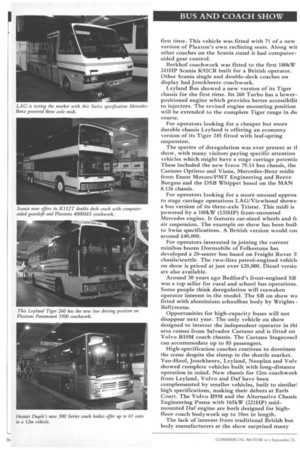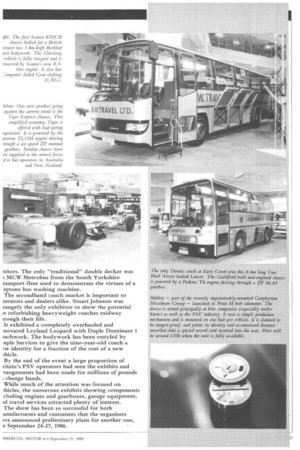BUYING TIME
Page 27

Page 28

Page 29

If you've noticed an error in this article please click here to report it so we can fix it.
Noel Millier reports some lively business at Earls Court
BUS and coach operators from all over Britain and many from elsewhere came and did business at the first International Bus & Coach Exhibition at Earls Court.
Among the first exhibitors to receive firm orders was Hestair Duple which used the event to launch its brand new 300 body range. The Laser and Caribbean models have now been replaced by the low-floor 320 and high-floor 350 models.
Duple offers a number of differing equipment levels — L, SL, SLX and EX — to meet all requirements. The L is the lowest specification and the EX the top-luxury version although specifications can be adapted to meet individual requirements.
Both the 320 and 350 share the same basic design with common panels and window glass. The only major differences are in the actual body height and luggage locker capacity. Duple considers it has made a major breakthrough by accommodating increased passenger capacities in its new range.
By using its new GA300 seat design Duple can accommodate up to 61 passengers on fixed seats or 57 on recliners in 12m coaches. The new seats are designed to provide as much comfort and more strength than those they replaced, and are based on GRP shells.
The 300 series features microprocessor-controlled ducted heating which incorporates side window demisting and is designed to provide consistent levels of heat throughout the vehicle interior. Interiors have been designed with safety in mind and full soft trim is used with no hard edges.
The new bodies meet all proposed safety and roll over regulations according to Duple. They have also been designed to be as aerodynamic as possible. Bonded glazing and a smooth roof with no openings or air vents reduce drag significantly.
On the first day of the show four Duple 320 bodied coaches were ordered by Capital Coaches of Heathrow.
Disappointingly, some expected exhibits did not appear. The Van-Hool-bodied double-decker on the Volvo BlOMT chassis was not completed in time, and Leyland's Lynx single-decker was again exhibited in superstructure-frame only form. However, a number of new chassis variations and body/chassis combinations were featured.
Scania showed its K112TR three-axle chassis fitted with Plaxton's Paramount 4000MS bodywork for the first time. This vehicle was fitted with 71 of a new version of Plaxton's own reclining seats. Along wit other coaches on the Scania stand it had computeraided gear control.
Berkhof coachwork was fitted to the first 180kW 241HP Scania K92CR built for a British operator. Other Scania single and double-deck coaches on display had Jonckheere coachwork.
Leyland Bus showed a new version of its Tiger chassis for the first time. Its 260 Turbo has a lowerpositioned engine which provides better accessibilit to injectors. The revised engine mounting position will be extended to the complete Tiger range in du course.
For operators looking for a cheaper but more durable chassis Leyland is offering an economy version of its Tiger 245 fitted with leaf-spring suspension.
The spectre of deregulation was ever present at tl show, with many visitors paying specific attention vehicles which might have a stage carriage potentia These included the new Iveco 79.14 bus chassis, the Caetano Optimo and Viana, Mercedes-Benz midis from Ensor Motors/PMT Engineering and Reeve Burgess and the DSB Whippet based on the MAN 8.136 chassis.
For operators looking for a more unusual approa, to stage carriage operations LAG/Viewbond showe. a bus version of its three-axle Tristar. This midi is powered by a 100kW (135HP) front-mounted Mercedes engine. It features car-sized wheels and ft air suspension. The example on show has been buil' to Swiss specifications. A British version would cos around £40,000.
For operators interested in joining the current minibus boom Dormobile of Folkestone has developed a 20-seater bus based on Freight Rover 3! chassis/scuttle. The two-litre petrol-engined vehich on show is priced at just over £20,000. Diesel versio are also available.
Around 30 years ago Bedford's front-engined SB was a top seller for rural and school bus operations. Some people think deregulation will reawaken operator interest in the model. The SB on show wa fitted with aluminium schoolbus body by Wrights Ballymena.
Opportunities for high-capacity buses will not disappear next year. The only vehicle on show designed to interest the independent operator in thi area comes from Salvador Caetano and is fitted on Volvo B1OM coach chassis. The Caetano Stagecoacl can accommodate up to 85 passengers.
High-specification coaches continue to dominate the scene despite the slump in the shuttle market. Van-Hool, Jonckheere, Leyland, Neoplan and Volv showed complete vehicles built with long-distance operation in mind. New chassis for 12m coachwork from Leyland, Volvo and Daf have been complemented by smaller vehicles, built to similar! high specifications, making their debuts at Earls Court. The Volvo B9M and the Alternative Chassis Engineering Puma with 165kW (221HP) midmounted Daf engine are both designed for highfloor coach bodywork up to 10m in length.
The lack of interest from traditional British bus body manufacturers at the show surprised many isitors. The only "traditional" double decker was 1 MCW Metrobus from the South Yorkshire ransport fleet used to demonstrate the virtues of a eptune bus washing machine.
The secondhand coach market is important to perators and dealers alike. Stuart Johnson was rangely the only exhibitor to show the potential Pr refurbishing heavyweight coaches midway krough their life.
It exhibited a completely overhauled and ,novated Leyland Leopard with Duple Dominant 1 iachwork. The bodywork has been restyled by uple Services to give the nine-year-old coach a Pw identity for a fraction of the cost of a new By the end of the event a large proportion of ritain's PSV operators had seen the exhibits and Yangements had been made for millions of pounds change hands.
While much of the attention was focused on glides, the numerous exhibits showing components eluding engines and gearboxes, garage equipment, id travel services attracted plenty of interest. The show has been so successful for both ianufacturers and customers that the organisers rye announced preliminary plans for another one, September 24-27, 1986.




































































































